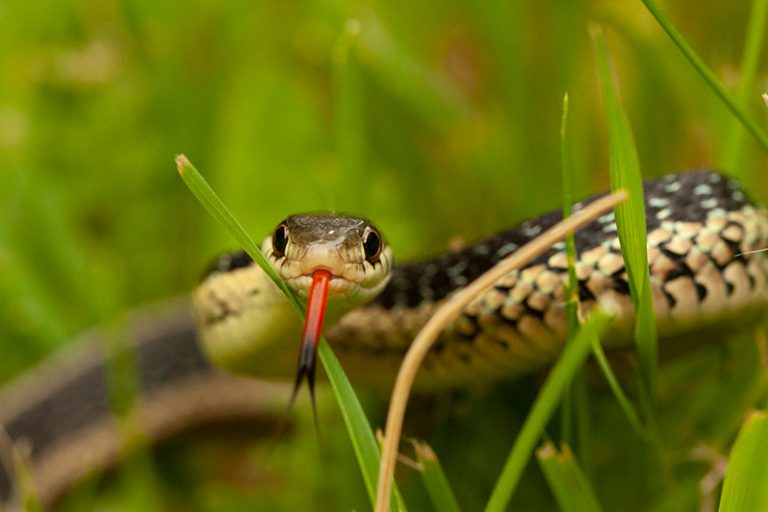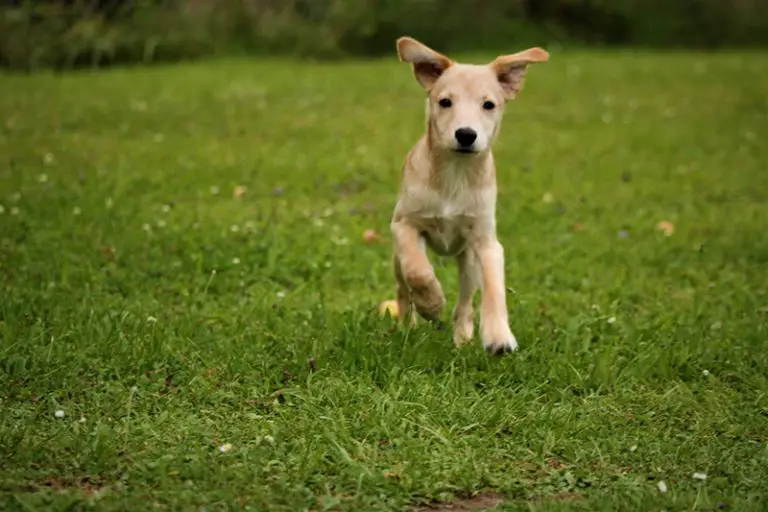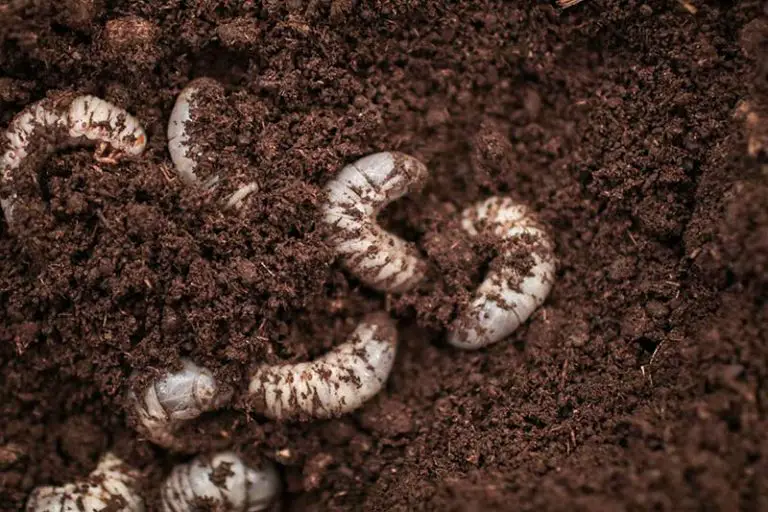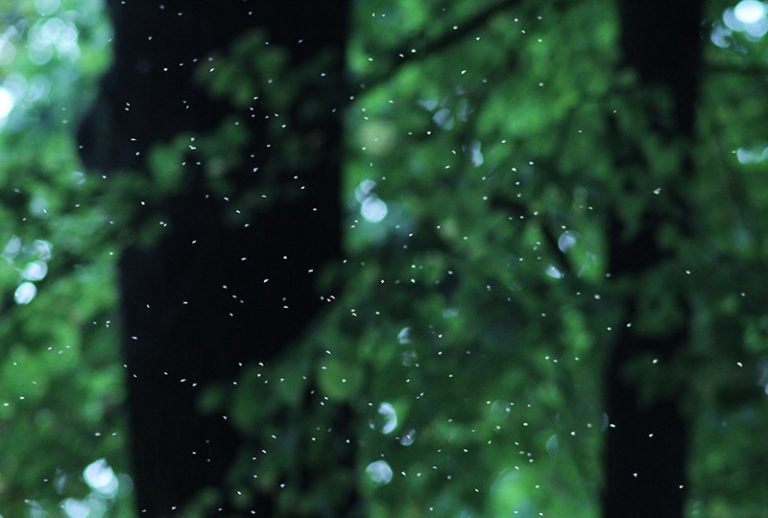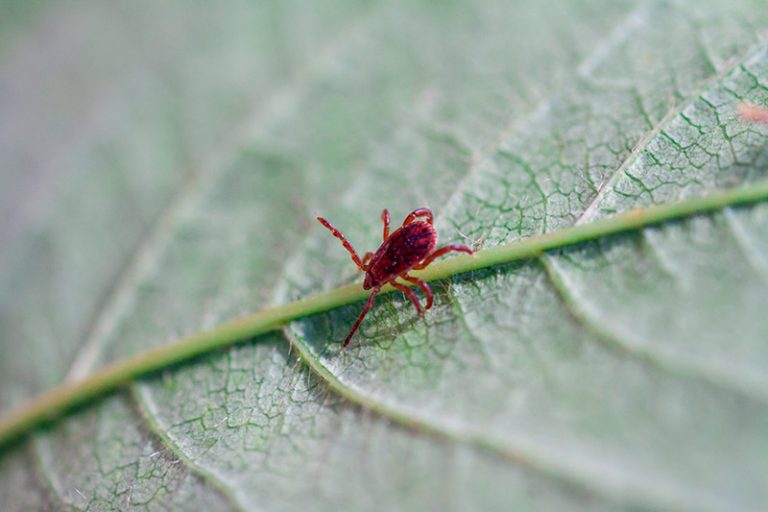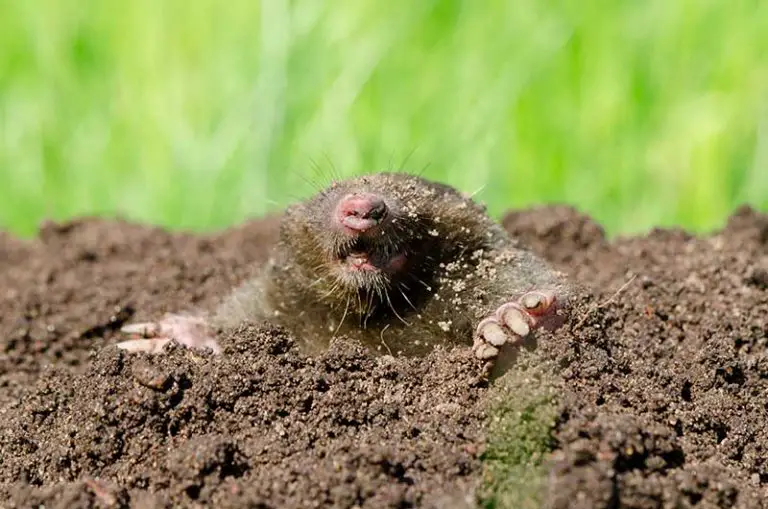How to Get Rid of Chinch Bugs and Repair Chinch Bug Lawn Damage
Chinch bugs are one of the most common types of lawn pests found in yards across all regions of the US. Even though these insects are small in size, they can do a lot of damage when present in high numbers. Their feeding habits can devastate expansive areas of turf in your yard, causing patches of grass to turn brown before dying off completely.
For small infestations, you can get rid of chinch bugs using non-chemical cultural methods of control such as aerating, dethatching, and overseeding your lawn. To kill the chinch bugs directly with an organic method, you can use diatomaceous earth. For larger infestations, you can apply chemical pesticides to get rid of chinch bugs in higher numbers.
In this guide, we explain the conditions that encourage the presence of chinch bugs and how to identify these pests. We have also gone through several different chemical and non-chemical methods to get rid of chinch bugs, repair the damage they cause, and prevent them from returning to your lawn.
What Are Chinch Bugs?
Chinch bugs are small black insects common to lawns throughout the US. When present in large populations, chinch bugs are destructive lawn pests that can cause significant damage to grass.
There are four different types of chinch bugs found in US lawns; hairy chinch bugs, common chinch bugs, southern chinch bugs, and western chinch bugs. The different species vary in appearance and locality throughout the country.
Where Are Chinch Bugs Found In Your Lawn?
Drought-Prone Areas
When chinch bugs are present in high numbers, they tend to congregate and cause damage in localized patches. This will typically take place in more drought-prone areas of the lawn that experience extreme heat or sun exposure. These areas dry out more quickly than the others, resulting in stressed grass that’s more susceptible to chinch bug damage. The parts of your lawn vulnerable to these conditions include:
- Southern-facing slopes
- Areas along driveways or patios
- Areas that have sandy soil and see full sun
Thatch Layers
Chinch bugs live in the thatch layer of your lawn; this is the layer of organic matter that sits between the soil surface and the upward growth of your grass. They sit on this layer and feed on your grass plants by consuming the plant juices through piercings they make with their mouths. If you have a thick layer of thatch, you’re providing chinch bugs with their ideal habitat to live and feed.
How Do Chinch Bugs Damage Grass?
In the process of feeding on the plants, chinch bugs damage grass in two ways.
Firstly, they damage the plants when they use their mouths to bore into the grass stems. After boring into the stem, the chinch bugs then suck the sap out from within the plants. This feeding process weakens the grass as it draws off essential water and nutrients from the plants.
Secondly, the process further damages grass due to the saliva that the chinch bugs produce when feeding. As the bugs suck up sap, they inject their saliva back into the grass plants. This saliva contains an enzyme that breaks down the grass plant to enable easier feeding for the bugs. Even after the chinch bugs have finished feeding, their saliva continues to destroy the grass plants from the inside out. This causes the grass to turn yellow or brown, ultimately killing it off completely.
What Time of Year Do Chinch Bugs Damage Grass?
The exact time of year that chinch bugs become most active depends on your location and its usual climate conditions. Generally speaking, chinch bugs tend to begin their activity in the early spring. They become most active during late June to September when temperatures are at their warmest. This is when chinch bugs damage grass the most; the majority of people see the worst chinch bug damage around the start of August.
Signs of Chinch Bugs Damage in Grass
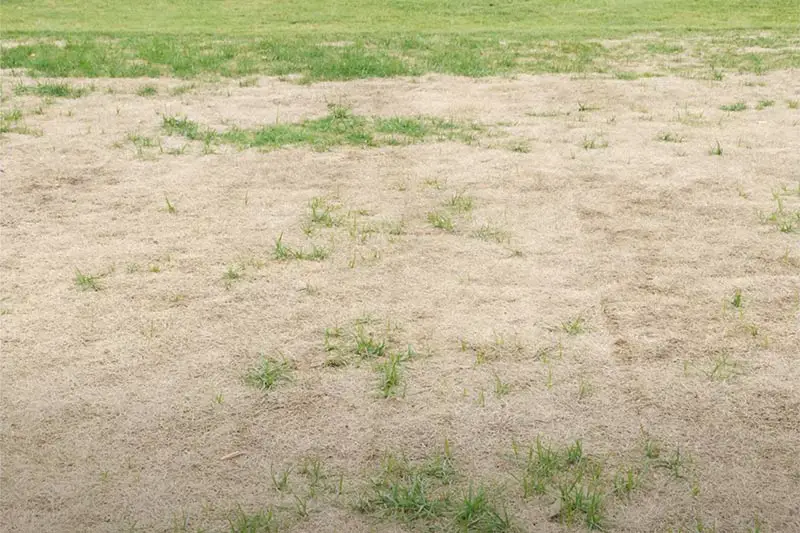
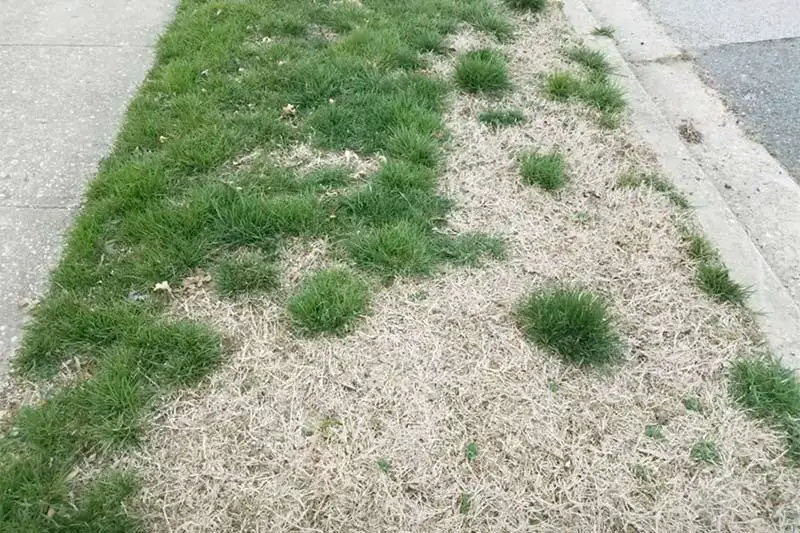
Irregular, Discolored or Dead Patches of Grass
Chinch bug damage will show up as irregular patches of discoloration throughout your lawn. It appears very similar to the damage caused by drought stress or fungal infestations like brown patch lawn disease. The grass in the affected patches will turn yellow or brown before dying off completely. The dead patches will have an outside margin of yellowing, stunted grass, and will begin to fill with weeds.
Seeing Chinch Bugs
While chinch bugs are small, they may be visible to the naked eye or with a magnifying glass. If you already have visible patches of damage on your lawn, inspect them more closely. Where the stressed grass meets the healthy grass, gently spread the grass apart with your hands. Look at the thatch layer and soil surface underneath the blades; you may be able to see the chinch bugs scurrying around, particularly on warmer days when they’re most active.
How to Conduct a Float Test
If you’re struggling to find the chinch bugs among your dead grass by eye, you can conduct a float test to determine these are the pests you’re dealing with.
1. Take a can such as an empty coffee canister or one similar to this.
2. Remove both ends of the can with a can opener so that it is open on the top and bottom.
3. Dig a small hole three inches deep into the soil in a chinch bug-damaged area.
4. Place the open-ended can into the hole and fill it ¾ of the way full with water.
5. Let the can sit for ten minutes before agitating the water to check for chinch bugs – see the following section for identification tips.
What Do Chinch Bugs Look Like?
Size: Chinch bugs are very small insects, with adult chinch bugs only growing to measure ⅕ of an inch long.
Shape: Chinch bugs have bodies that are oval-shaped. Adult chinch bugs have two overlapping wings, while immature chinch bugs lack wings. All ages of chinch bugs have long mouthparts.
Color: Chinch bugs range in color throughout their life cycle. Immature chinch bugs start off as bright orange, with their bodies darkening as they age to black. Adult chinch bugs have light brown legs and have two white wings. Each wing has a black triangle shape at its outer edge.
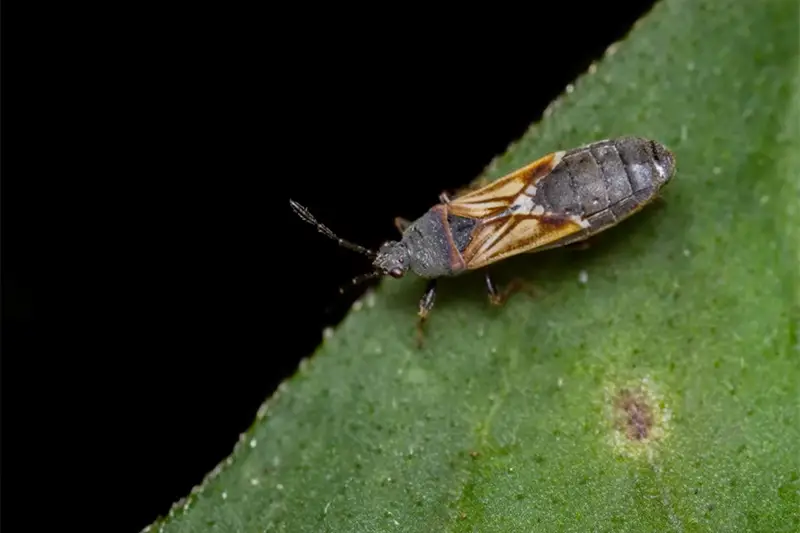
Chinch Bug Identification By Species
Hairy Chinch Bug
Where Found: The hairy chinch bug is the most common type found in northern turfgrasses in the US. These bugs are found throughout the midwest and northeastern states, living in lawns as far as the south of Canada.
Identification: Immature hairy chinch bugs are brick-red with a band of white running across their back. Adult hairy chinch bugs have gray-black bodies that are covered in fine hairs and reddish-colored legs. They have white wings with small, black, triangle-shaped spots on the outer margin of each wing. Hairy chinch bugs measure to be about ⅙ of an inch long.
Grass types that hairy chinch bugs prefer:
- Bentgrass
- Fine fescues
- Kentucky bluegrass
- Perennial ryegrasses
- Zoysia grass
Common Chinch Bug
Where Found: Common chinch bugs typically live in lawns from South Dakota to Virginia, spanning in a line from mid-Texas to mid-Georgia.
Identification: Immature common chinch bugs have reddish wingless bodies. Mature common chinch bugs have black bodies with a distinctive lighter hourglass shape across their back.
Grass types that common chinch bugs prefer:
- Bermudagrass
- Fescue
- Zoysia grass
Western Chinch Bug
Where Found: Western chinch bugs are found in the western states, spanning from Oklahoma and Texas to California.
Identification: Immature western chinch bugs have tiny, bright red bodies with a band of white around the abdomen. As they mature, they transition through an orange-brown color to black. Mature western chich bugs measure to be about 1/10 of an inch long.
Grass types that western chinch bugs prefer:
- Buffalograss
- Kentucky bluegrass
- Perennial rye
- Zoysia grass
Southern Chinch Bug
Where Found: Southern chinch bugs live in lawns throughout the entirety of the southeastern US states.
Identification: Immature southern chinch bugs will be bright red or greyish in color and have a white line running across their back. Mature southern chinch bugs are typically colored in dark red, brown, or black, and have a band of white around the center of their bodies. Some types of southern chinch bug will also have two white spots on their back. They measure to be about 1/10th of an inch in length.
Grass types that southern chinch bugs prefer:
- St. Augustine grass
- Bahiagrass
- Bermudagrass
- Centipedegrass
- Zoysia grass
What Causes Chinch Bugs to Take Over Your Lawn?
Having a Thick Thatch Layer
As the thatch layer is where chinch bugs reside in your lawn, a thick layer encourages their presence in high numbers. The tangled organic matter provides them with an ideal protective home. A thick layer of thatch also makes chinch bug control more challenging, as it reduces the effectiveness of chemical insecticides. All lawns have some amount of thatch, but problems like chinch bugs arise when the layer measures over 1 inch thick.
Using Too Much Fertilizer
Thatch build-up occurs when the grass grows too quickly for the decomposition of the dead organic matter on the lawn. As fertilizer stimulates plant growth, it will also increase the rate of thatch build-up, in turn encouraging the presence of chinch bugs. This is particularly true if you use synthetic, high-nitrogen fertilizers.
Watering Too Little
Chinch bugs are able to thrive equally in lawns that are both over or underwatered. In a drought-stressed lawn, the grass is more susceptible to the damage caused by the chinch bugs’ feeding process. Also, they prefer these conditions for their eggs and young, as dry soil reduces the incidence of disease spreading within their populations.
Watering Too Much
Contrastingly, an overwatered lawn can encourage the presence of chinch bugs too. Overwatering the lawn causes your soil to become saturated, depriving it of oxygen. In this condition, your soil is unable to sustain the microbes responsible for decomposing the matter in the thatch layer. This may be another avenue to having a buildup that encourages the presence of high chinch bug populations.
How to Get Rid of Chinch Bugs
For smaller infestations, you can use an organic method of chinch bug control by applying diatomaceous earth. For larger infestations, chemical chinch bug control may be necessary to get rid of the pests.
How to Get Rid of Chinch Bugs Using Diatomaceous Earth
For smaller chinch bug infestations, you can use diatomaceous earth. This is the more eco-friendly option compared to chemical methods of chinch bug control. Diatomaceous earth is a dust made from ground-up fossils that appears soft and powdery.
Despite this appearance, the microscopic particles of the dust are razor-sharp, enough to lacerate the bodies of insects that crawl across them. Diatomaceous earth is also a desiccant, causing insects to dehydrate and die within a few days of coming into contact with it.
Method: Spread the diatomaceous earth throughout your lawn, paying particular attention to the areas infested with chinch bugs. To check whether the DE was effective, conduct a float test after a few days of application; you can refer to the steps explained earlier in this guide on how to conduct a float test. If the test reveals there are still moving bugs, repeat the application of the DE to your lawn. Test it again after a few more days to check for chinch bug activity.
How to Get Rid of Chinch Bugs Using Chemical Pesticides
For larger infestations, you may want to opt for a chemical chinch bug control product. This method of chinch bug control is typically necessary when chinch bug populations exceed 20 bugs per square foot, or if they’re present across 15 to 20 square feet of your yard. Take note that the pesticides will kill a lot of other lawn-friendly insects, so you should only opt for them when absolutely necessary.
Chemical pesticides work to kill chinch bugs in their nymph and adult stages throughout the summer when they are most active. These pesticides aren’t able to kill unhatched eggs, but they will take out any immature or adult chinch bugs effectively. For this reason, some products require two applications; the first application is to kill chinch bugs already hatched, then a second application several weeks later to kill chinch bugs that hatch from eggs after the first. Other pesticides contain slow-release chemicals that work to control chinch bug populations for up to three months.
Method: Choose an appropriate chinch bug control product. There is a variety of liquid and granular products available; you should look for a product containing the ingredients bifenthrin, carbaryl, or Trichlorfon. Read the application and safety instructions carefully as exact directions will vary from product to product.
The typical approach to the application of chemical insecticides is to apply them in early to mid-June. This is when the chinch bugs will begin to move into your lawn for the summer. If you don’t notice the bugs until July or August when they’re at their peak, you can still use insecticide to control the bugs relatively well. If you have an unusually large infestation, you will need to make a reapplication of the insecticide two to three weeks later.
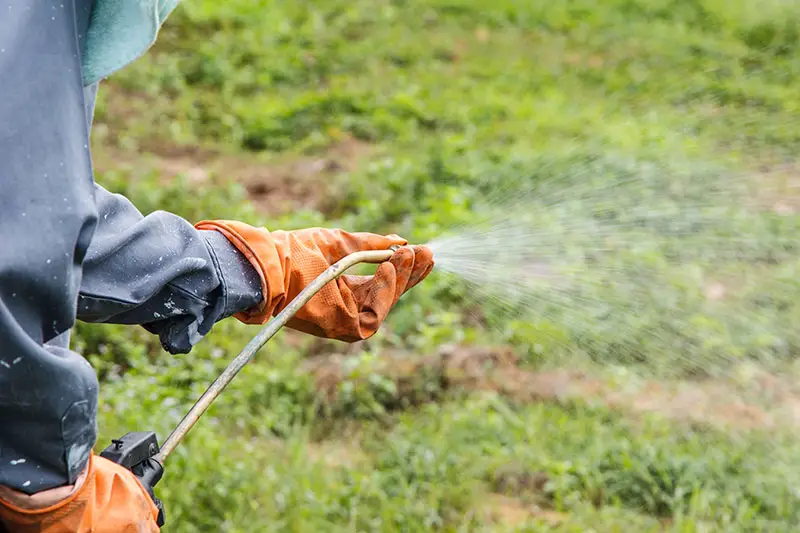
Chinch Bug Damage Repair And Prevention
Once you have managed to get rid of the chinch bugs from your lawn, you can follow these steps towards repairing your grass and protecting it against future chinch bug infestations.
Test Soil
After you have managed to get rid of chinch bugs, you should first test your soil. The results of this test will reveal the soil’s pH and nutrient levels. You can use these results to determine whether your soil is in the right conditions for regrowth, or whether you need to add amendments or pH adjusting materials beforehand.
Overseed Bare Patches from Chinch Bug Damage
Once your soil is ready for planting, overseed your lawn with new grass seed. This will help you to repair the chinch bug damage while also strengthening your grass against future infestations. If you’ve used chemical insecticide and you’re in between multiple applications, you can still reseed your lawn.
When it comes to the best seed for overseeding, this will depend on the area that you live in. The first option is to seed with a hardy grass type suitable for your area, whether that’s northern or southern.
Alternatively, for enhanced protection, you could overseed with an endophyte-enhanced grass seed. This option is only available to those in northern regions that have bluegrass, ryegrass, or tall fescue. The grass plants that grow from endophyte-enhanced seeds have fungi within their cells known as endophytes. These beneficial fungi give the grass enhanced resistance to damage from insects, drought, and fungal disease.
Water Lawn Properly
Keeping up with a proper watering schedule will help to repair chinch bug damage, in addition to protecting your grass from future infestations. Water your lawn appropriately for your grass type and the weather conditions of your area. Most established lawns typically require about 1 to 1.5 inches of water per week, split into one or two watering sessions.
Dethatch Lawn As Part of Annual Lawn Care Routine
Dethatching your lawn is a beneficial practice for a number of reasons, including protecting it against harmful bugs like chinch bugs. Removing the thatch layer removes the protective environment that invites chinch bugs into your lawn. It also helps to reduce the chances of female chinch bugs laying their eggs in your lawn. Dethatch your lawn as part of your annual maintenance to keep it in optimal condition and uninviting to unfriendly insects.
Follow ⅓ Rule When Mowing Grass
To ensure your grass is in the best condition, always follow the ⅓ rule when you mow. You should never take off more than ⅓ of the grass blades’ total height per mowing session; cutting the grass shorter than this weakens the plant and leaves it more susceptible to damage from pests and disease.
Mow Grass to Optimal Height
Mow your lawn so that it’s as high as recommended for your grass type. Keeping the grass as long as possible helps the soil to retain moisture, as well as moderating the soil temperature. This in turn discourages chinch bugs from moving in by removing their favored hot and dry environment.
The best height to mow grass varies between types, so you’ll need to find out information on your specific species and adjust your mowing height appropriately. As a general idea, most turfgrasses should be mowed to a height between 2 and 4 inches.
Avoid Over-Fertilization
While fertilization is an essential lawn care practice, overapplication of fertilizer can worsen a chinch bug infestation. Also, trying to amend chinch bug damage with fertilizers may also result in bigger problems like fertilizer runoff. Incorporate moderate, regular fertilizer applications into your lawn care routine, using a slow-release, organic fertilizer. Avoid using synthetic high-nitrogen formulas that promise instant results as these encourage thatch buildup. Also, be mindful that the shadier parts of your lawn will require less fertilizer than those in full sun.
Encourage Chinch Bug Predators
You can control smaller populations of chinch bugs by encouraging the presence of chinch bug predators. There are a few lawn-friendly insects that prey on and kill chinch bugs, including ladybugs, ground beetles, and big-eyed bugs. Make sure to never use chemical pesticides that kill indiscriminately as a method to kill chinch bugs unless absolutely necessary. These will wipe out the lawn-friendly bugs that help to keep populations of harmful insects like chinch bugs under control.

